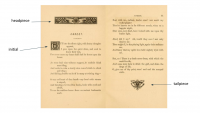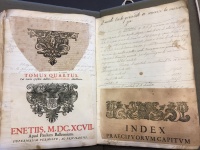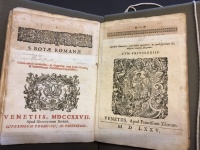Printer's Ornaments
Introduction
Have you ever flipped through a book and noticed stylized and colored letters or borders? Have you ever wondered why they were emphasized? These letters are derivatives of printer’s ornaments, decorations used for both form and function in printing. But what exactly are printer’s ornaments, and why should we care? Through the analysis of two objects pertaining to printer’s ornaments—as well as a miniature case study on a particular printer’s ornament—we will see how the significance of printer’s ornaments has developed and changed between different cultures and time periods.
Printer's Ornaments 101

Printer’s ornaments (other names include wingdings and printer’s flowers) is a fairly all-encompassing term describing printed decorative and stylistic elements used in books that replaced hand-drawn letters and decorations found in early monastic scripts [1] [2]. A more technologically-specific definition refers to printer’s ornaments themselves as wooden or metal letterpress blocks engraved with relief designs for printing alongside the text of a book [2]. There are many different types of printer’s ornaments, the most common being headpieces, tailpieces, and initials that are found on page tops, page bottoms, and section headings, respectively (see Fig. 1). Printer’s ornaments were carved out of blocks using sharp burins, and either simultaneously printed alongside text or printed in subsequent steps [3]. Printer’s ornaments served a wide variety of purposes in both form and function. They added beauty and color to otherwise black text, and some even provided information towards understanding the text. On a more practical note, printer’s ornaments provided support in empty spaces within a printing frame, thereby preventing warping or distortion of paper and ensuring a certain quality of print [2]. Moreover, some printer’s ornaments were accompanied by information about the printer, location, and year in which the text was printed [4].
As printing entered the digital age, printer’s ornaments lost their practical, page-holding purposes and are now relatively obsolete. However, historical remnants of printer’s ornaments exist within volumes such as Album de stampine antiche and Henry Plomer’s English Printers’ Ornaments. These two volumes represent two very different perspectives on “collecting” and “reading” printer’s ornaments, especially since they demonstrate a trend in printer’s ornaments from aesthetic visuals to scholarly resources in different time periods. Moreover, the portability—both physical and meaningful—of printer’s ornaments can be explored through a brief study of a reoccurring printer’s ornament depicting a bear-hunting scene, with this particular ornament present in both Album and English Printers’ Ornaments and how this particular ornament was presented in these volumes.
Album de stampine antiche

The Album de stampine antiche (or “Antique stamps album”) is a phenomenal example of a compilation of printer’s ornaments. Created during the nineteenth century in Florence, Italy, Album is a scrapbook that contains hundreds of cutouts from books, featuring over 350 different kinds of printer’s ornaments. The creator of Album has remained unknown; however, it is believed that someone in the Peruzzi family was involved, seeing as there are many instances of a “Caroli Peruzzi” leaving his signature within the book. The printer’s ornaments featured are all from books published between the mid-sixteenth to late-eighteenth centuries, thereby demonstrating the longevity of printer’s ornaments during the time [5]. These printer’s ornaments are especially unique because they are all cutouts, specimens of original pieces from books (as opposed to reproductions or scans). Additionally, Album is not a book solely dedicated to printer’s ornaments; the scrapbook element comes from the fact that these cutouts were pasted on top of a book that was previously used for business transactions of a sort, a nod towards the possibility of the Peruzzi family being involved in the creation of Album as they were a prominent banking family at the time (see Fig. 2). The juxtaposition of calligraphic text against bold images is quite vivid and highlights the scrapbook elements of Album quite well.

Another notable physical feature of Album includes its composition of printer’s ornaments which highlights the creator's choices. Many of the printer’s ornaments were cut from title pages, and whoever cut them out also included surrounding printed information on the title, publisher, and location and date of production as well. While most locations were domestic—Venice, Rome, Florence, for instance—others were international—take Geneva, Lyon—thus demonstrating how book production and circulation was widespread throughout Europe at the time. From a purely syntax perspective, printer's ornaments only refer to the images themselves (and not the the words), so the fact that the creator decided to cut out these additional snippets speaks to the idea of aesthetics in identification, as if the printer's ornaments themselves "lose" meaning without the titles, locations, or dates.
English Printers' Ornaments
A Peculiar Case of Bears
More Stuff!
Notes
- ↑ Reilly, Elizabeth Carroll. A dictionary of colonial American printer’s ornaments and illustrations. American Antiquarian Society, 1975.
- ↑ 2.0 2.1 2.2 Plomer, Henry R. English Printers’ Ornaments. Grafton & Co. Coptic House, 1914. (digitizing sponsored by York University—University of Toronto Libraries)
- ↑ A Database of Eighteenth-Century Printers’ Ornaments. Fleuron: A Database of Eighteenth-Century Printers’ Ornaments, fleuron.lib.cam.ac.uk/index.
- ↑ Creel, Sarah, “(Re)framing Eliza Haywood: Portraiture, Printer’s Ornaments, and the Fashioning of Female Authorship.” Journal for Early Modern Cultural Studies. Vol. 14., No. 4, University of Pennsylvania Press, 2014.
- ↑ “Album de stampine antiche.” University of Pennsylvania Finding Aids, http://dla.library.upenn.edu/cocoon/dla/ead/ead.html?start=25&id=EAD_upenn_rbml_PUSpMsCodex1859&.
Album de stampine antiche, Ms. Codex 1859, Kislak Center for Special Collections, Rare Books and Manuscripts, University of Pennsylvania.
“Album de stampine antiche.” University of Pennsylvania Finding Aids, http://dla.library.upenn.edu/cocoon/dla/ead/ead.html?start=25&id=EAD_upenn_rbml_PUSpMsCodex1859&